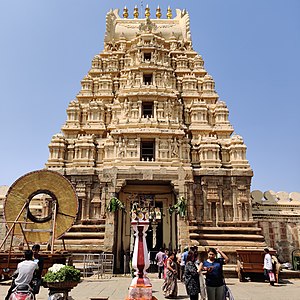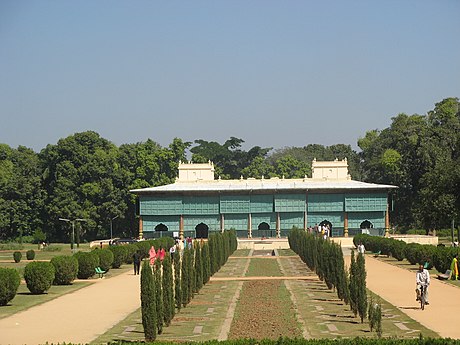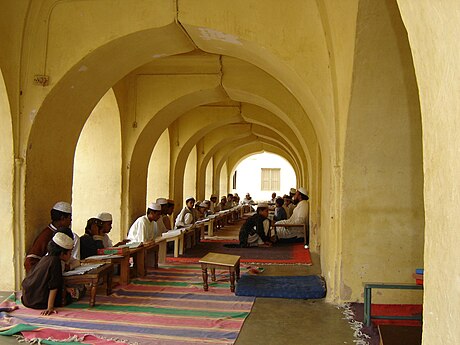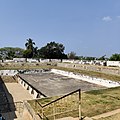Srirangapatna
This article needs additional citations for verification. (November 2017) |
Srirangapatna
ಶ್ರೀರಂಗಪಟ್ಟಣ
(Shreerangapattana) Seringapatam | |
|---|---|
Town | |
UTC+5:30 (IST) | |
| PIN | 571 438 |
| Telephone code | 08236 |
| Vehicle registration | KA-11 |
| Website | www |
Srirangapatna is a town and headquarters of one of the seven
The monuments on the island town of Srirangapatna have been nominated as a UNESCO World Heritage Site, and the application is pending on the tentative list of UNESCO.[2]
History
Srirangapatna has since time immemorial been an urban center and place of pilgrimage. During the
Srirangapatna remained part of the Kingdom of Mysore from 1610 to after India's independence in 1947; as the fortress closest to the capital city of Mysore, it was the last bastion and defence of the kingdom in case of invasion.
Hyder and Tipu
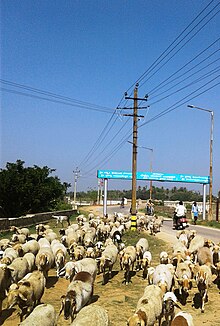
Srirangapatna became the capital of Mysore under Hyder Ali and Tipu Sultan.[4][5] When Tipu finally dispensed with the charade of deference to the Wodeyar Maharaja who was actually his captive, and proclaimed the "Khudadad State" under his own kingship, though the then incumbent Wodeyar scion Chamaraja Wodeyar IX was still officially the king of Mysore.
During Tipu Sultan's wars against the British, Kodavas, and Malabar rajas; he rounded up entire communities of
Treaty of Seringapatam, 1792
The Treaty of Seringapatam (also called Srirangapatna), signed 18 March 1792, ended the Third Anglo-Mysore War. Its signatories included Lord Cornwallis on behalf of the British East India Company, representatives of the Nizam of Hyderabad and the Maratha Empire, and Tipu Sultan, the ruler of Mysore.
Battle of Seringapatam, 1799
Srirangapatna was the scene of the last and decisive battle of the Fourth Anglo-Mysore War, fought in 1799 between Tipu Sultan, ruler of Mysore, and a combined force of 50,000 men provided equally by the Nizam of Hyderabad and the East India Company, under the overall command of General George Harris.
At the battle's climax, Tipu Sultan was killed within the fort of Seringapatam, betrayed by one of his own confidants. The spot where he fell is today marked by a memorial. Although the joint forces of the victorious army plundered Seringapatam and ransacked Tipu's palace, much of the site of the battle is still intact, including the ramparts, the Water Gate, the area where British prisoners were held, and the site of the destroyed palace.[6]
Apart from the usual gold and cash, innumerable other valuables were shipped to England, including objets d'art and personal possessions of Tipu Sultan such as his rich clothing, shoes, sword, and firearms. Most of these remain in the British Royal Collection and in the Victoria and Albert Museum, the latter of which holds Tipu's Tiger, an automaton of a tiger on top of a British soldier. The sword of Tipu Sultan was purchased at a Sotheby's auction by Vijay Mallya, a liquor baron from Karnataka.
British composer Harriet Wainwright composed a work for chorus ("Seringapatam") about the battle.
Location


Although situated only 15 km (9.3 mi) from
Religious significance
The town takes its name from the celebrated
Tradition holds that all the islands formed in the
- Adi Ranga: the
- Madhya Ranga: the
- Antya Ranga: the Sri Ranganathaswamy Temple at Srirangam, Srirangam taluk, Tiruchirappalli district, Tamil Nadu, India
The presence of the Kaveri River is in itself considered auspicious and sanctifying. The Paschima Vaahini section of the Kaveri at Srirangapatna is considered especially sacred; the pious come from far and wide to immerse the ashes of the departed and perform obsequies to their ancestors in these waters.
Demographics
According to the 2011 India Census Data, Srirangapatna had a population of 155,130 persons. Males constitute 50.06% and females constitute 49.93% of the total population. 9.80% of the population are under 6 years of age.[7]

Geography
Srirangapatna is at 12°25′N 76°42′E / 12.41°N 76.7°E. It has an average elevation of 679 metres (2,228 ft) above mean sea-level.
Places of interest
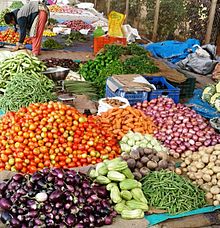
The town is famous for a very ancient temple dedicated to Sri
Sri Ranganathaswamy Temple
-
Ranganathaswamy Temple, Srirangapatna
-
Elephant Gate
The Ranganthaswamy Temple – usually referred to as "Sri Ranganathaswamy" – is dedicated to Ranganatha, a manifestation of Vishnu. It is one of the five important pilgrimage sites along the river Kaveri for devotees of Ranganatha. These five sacred sites are together known as Pancharanga Kshetrams in Southern India. Since Srirangapatna is the first temple starting from upstream, the deity is known as Adi Ranga (lit; "first Ranga"), and the town of Srirangapatna, which derives its name from the temple, is on an island in the river Kaveri.
Daria Daulat Bagh
-
Palace of Tipu Sultan
-
The Jama Masjid
The Dariya Daulat Palace (Summer Palace) is set amidst beautiful gardens called Daria Daulat Bagh. Tippu Sultan built this palace in 1784. The palace is built in the Indo-Saracenic style is mostly made of teakwood. The palace has a rectangular plan and is built on a raised platform.
Other attractions in Srirangapatna include the
Tipu Sultan Gumbaz
The Gumbaz is an impeccably detailed mausoleum and houses the remains of Tipu Sultan, his father Hyder Ali and his mother Fatima Begum among beautifully manicured gardens. Various tombs of other relatives surround the gumbaz, some with small signs offering guidance on which specific individuals are buried here. The outer gumbaz columns are made of amphibolite, a very dark rock that exudes a somber richness. Handcrafted door frames covered in a deep lacquer finish lead into an inner tomb illuminated only by natural light. All visitors are welcome inside, and even encouraged to enter by the friendly doormen.
Wellesley Bridge
Wellesley Bridge was erected by Kingdom of Mysore's Dewan, Purnaiah on the Kaveri river in 1804.[10] It was named after the then Governor General Marquis of Wellesley. The bridge is built of stone pillars and stone corbels and surrounded by stone girders. The bridge is very strong and has survived the heavy traffic of many years.[11][12]
Karighatta viewpoint
The
Nimishamba Temple
The famous
Garrison Cemetery, Srirangapatna
The Garrison Cemetery is located in Srirangapatna, on the banks of the river
Scott’s Bungalow, Seringapatam
The Scott’s Bungalow is located in
Lord Harris's House
Between the Garrison Cemetery and

Srirangapatna Fort
The fortress is in the west of the island, and is surrounded by double walls. The point at which the British broke through the walls, and thus Tipu Sultan's troops surprised, is marked by an obelisk. Also highlighted is the place where Tipu Sultan was killed by the British forces. In addition, the dungeon in which the Mysore rulers had imprisoned British soldiers.
Colonel Bailey's Dungeon
Colonel Bailey's Dungeon was the place where Tipu Sultan used to imprison all the British officers. It is near the death place memorial of Tipu Sultan and is surrounded by gardens on all four sides. Bailey was the only British officer who died in that place and could not make it through the tough conditions and so it was later named after him.
Another version says that the commanding officer of the British at the
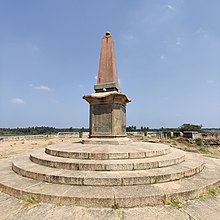
Obelisk Monument
Ranganathittu Bird Sanctuary
Near the town is the
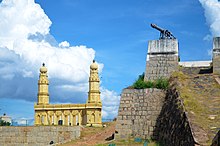
In literature
- Duke of Wellington.
- Wilkie Collins' The Moonstone[20] includes a prologue that takes place during the Battle of Srirangapatna, entitled "The Storming of Seringapatam (1799)", during which a British officer steals a sacred Hindu diamond that becomes the mystery at the centre of the novel.
- John Forster mentions in The Life of Charles Dickens that in a childhood playground of C.D., "he had been... delivered from the dungeons of Seringapatam, an immense pile ('of haycock'), by the victorious British ('boy next door and his two cousins')...". See p. 10 of the Everyman edition published in 1969. First published: London; Chapman and Hall, 1872–1874, in 3 volumes.
Image gallery
-
Obelisk Monument
-
Colonel Bailey's Dungeon, Srirangapatna
-
Ranganathaswamy Temple, Srirangapatna
-
Sangama
-
Old Bridge
-
Tippu School
-
Karigatta viewpoint
-
Tippu Tomb
-
Srirangapatna
-
Wellesley Bridge Temple
See also
References
- ^ "Census Data Handbook 2011" (PDF). Retrieved 3 August 2023.
- ^ Monuments of Srirangapatna Island Town, UNESCO
- Wodeyar dynasty in 1614 is much celebrated in local ballad and legend, one of which concerns a curse put upon the Wodeyars by Alamelamma, the lamenting wife of the defeated Vijayanagar viceroy. In fulfillment of that curse, no ruling Maharajaof Mysore has ever had children; the succession has inevitably devolved upon brothers, nephews or adopted heirs, or on children born to the Maharaja before his accession, but never has a child been born to a ruling Maharaja.
- ^ "Introduction". Seringapatam 1799. Macquarie University. Retrieved 11 January 2011.
- ^ "General Information".
- ^ Siege of Seringapatam (1799)#Legacy
- ^ "2011 India Census Mandya Data" (PDF). censusindia.gov.in.
- ^ "Population by religion community – 2011". Census of India, 2011. The Registrar General & Census Commissioner, India. Archived from the original on 25 August 2015.
- ^ Charya, S V Upendra (13 August 2013). "Where Tipu Sultan used to pray". Deccan Herald. No. Bangalore. Retrieved 2 February 2015.
- ^ "www.mysore.ind.in - mysore.ind.in - Devaraja Market - Everything about Mysore Attractions !". mysore.ind.in. Retrieved 30 June 2017.
- ^ Wright, Colin. "The Wellesley Bridge, Seringapatam". www.bl.uk. Retrieved 30 June 2017.
- ^ Photos, Old Indian. "The Wellesley Bridge in Srirangapatna, Karnataka - c1850's". www.oldindianphotos.in. Retrieved 30 June 2017.
- ^ Kumar, M T Shiva (9 March 2013). "There is life at the cemetery". The Hindu. No. Bangalore. Retrieved 3 February 2015.
- ^ "Garrison Cemetery". Mysore. Retrieved 3 February 2015.
- ^ Chetti, P Stephen Basappa (1897). A Guide to Seringapatam and Its Vicinity; Historical and Traditional. Mysore (British India): Town Press. p. 24. Retrieved 25 September 2015.
- ^ "Scott's Bungalow". Mysore.ind. 2015. Retrieved 25 September 2015.
- ^ Harshitha, Samyuktha (12 March 2013). "The Srirangapatna that I know". Retrieved 25 September 2015.
- ^ Parsons, Constance E (1931). Seringapatam. H. Milford. pp. 155–157. Retrieved 25 September 2015.
- ^ "Sharpe's Tiger page from Cornwell's website". Archived from the original on 6 July 2011. Retrieved 30 June 2017.
- ^ The Moonstone by Wilkie Collins. Retrieved 30 June 2017 – via www.gutenberg.org.

